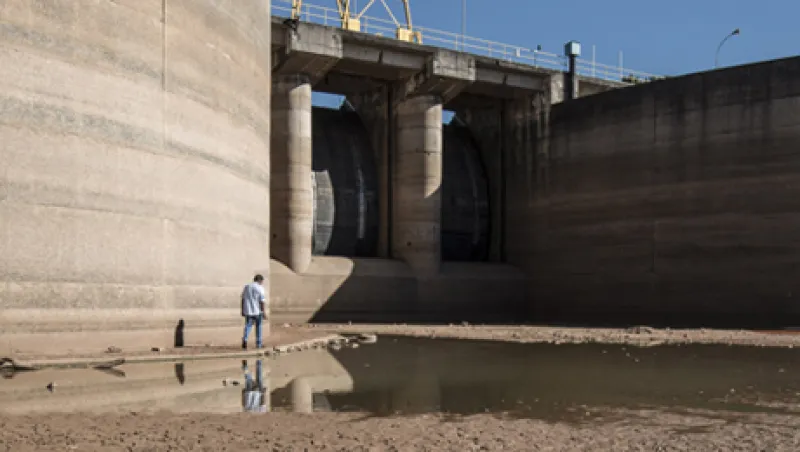Recent droughts show that extreme weather events linked to climate change are no longer a future economic threat but a present danger. India’s current severe dry spell will likely cost the country about $100 billion, according to the Associated Chambers of Commerce and Industry of India. A Brazilian drought that scorched São Paulo between 2014 and early this year may have shaved 2 percentage points off the capital region’s gross domestic product for the six months ended March 2015, economists estimate.
The economic effects of climate change are increasingly real and measurable, but that doesn’t mean they’re very well measured. Uncertainty about how drought and other weather patterns could wreak havoc on various regions of the world poses a growing problem for the banks that lend to businesses in those places. Seeking answers, several major banks have joined forces to help build a better tool for modeling drought-related default risk.
“At this point, not a lot of companies are thinking about environmental risks as a primary driver of portfolio credit risk,” says Dominic Smith, senior manager at Risk Management Solutions (RMS), a catastrophe-modeling firm based in Newark, California.
A 2013 report from HSBC Global Research concluded that although company leaders and financial analysts often fail to account for how the management of natural resources could affect business operations, that will soon have to change. “Natural capital factors are becoming a bigger driver of overall economic productivity,” the authors wrote. “Ultimately, this will impact the potential return profile of assets.” When it comes to natural capital, HSBC’s climate analysis revealed that the most urgent need is to incorporate water and carbon risk management into macroeconomic thinking, the report added.
A new public-private partnership aims to help fill that void. In May the Natural Capital Declaration (NCD), a joint financial sector initiative by the United Nations Environment Programme, the German government’s Emerging Markets Dialogue on Green Finance and the Global Canopy Programme, an Oxford, U.K.–based think tank devoted to preserving tropical forests, announced that it is developing a tool that banks can use in their lending portfolios to quantify the odds that companies in particular regions and industries will default due to extreme drought.
The project also involves nine banks from five countries, including Mexico’s Grupo Financiero Banorte, Itaú Unibanco of Brazil, New York–based Citigroup, Industrial and Commercial Bank of China and Switzerland’s UBS.
In the cities where banks do much of their business, dry weather may exact a steep price. The Lloyd’s City Risk Index, which is based on research by the Centre for Risk Studies at the University of Cambridge’s Judge Business School and measures the potential economic fallout from various man-made and natural risks facing urban centers, estimates that drought could cost the world’s 301 leading cities a total of more than $89 billion between 2015 and 2025.
“With the advances in data analysis, especially in the insurance modeling area, this project is trying to build on that knowledge in other sectors and bring it into banking,” says Liesel van Ast, Oxford-based head of the NCD. “It’s also trying to cross-pollinate between environmental knowledge and the financial sector, because this information can be a bit siloed, and to do it in a way that makes sense from a financial institution’s perspective as well as from a natural sciences perspective.”
The new tool differs from existing forecasting models, designed by climatologists to predict the likelihood of intensifying droughts over the next several decades. The NCD initiative will set its sights on the immediate future — 2017 through 2022 — and model the extent to which the extreme drought already evident in places like Australia, Brazil, India and the western U.S. could affect businesses across sectors and regions if it spreads elsewhere. Eventually, banks will be able to enter details about their lending portfolios and, based on borrowers’ locations, receive information about where default risks could lurk.
The NCD risk model will also report on the macroeconomic effects of extreme drought, focusing on four countries to start: Brazil, China, Mexico and the U.S. The participating banks will test the first version this summer, with fine-tuning by RMS to follow. For various drought scenarios, the tool will gauge the impact on inflation, employment and commodity prices — all metrics that have a significant effect on any financial institution.Liselotte Arni, Zurich-based head of environmental and social risk at UBS, notes that as her bank oversees internal stress tests to evaluate how a transition to a low-carbon economy will affect its balance sheet, she’s noticed weak spots in the testing. “We focus on drought risks because data is expected to be available and can be linked with financial risk analysis,” Arni says of the NCD collaboration.
RMS’s Smith hopes that companies most exposed to drought risk can also benefit from the model he’s building. “We feel it’s important to reward some of the mitigative steps that borrowers are taking in terms of their efficient use of water and to capture some of those effects in the lending process,” he says.






